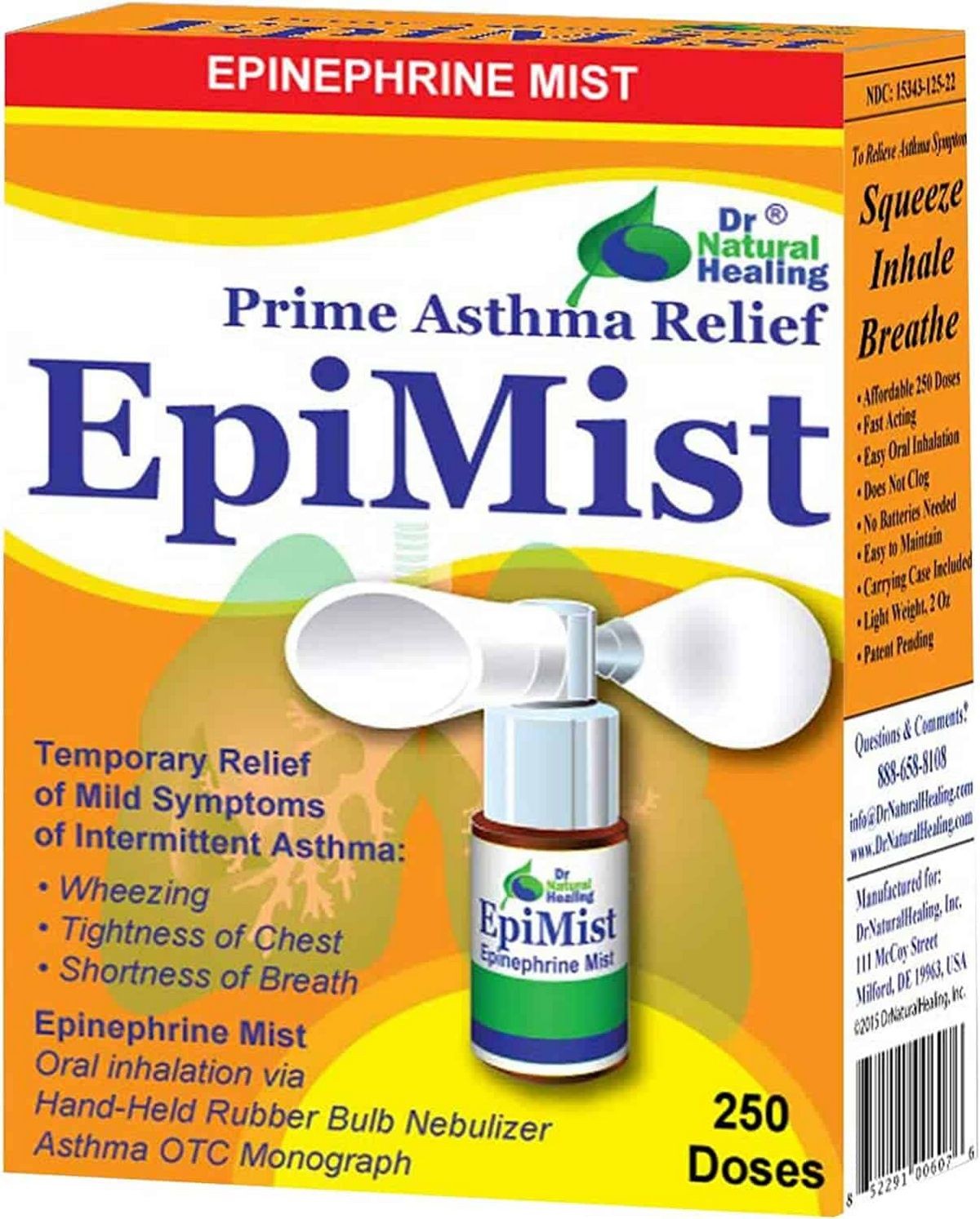
Contents
- 1 Epinephrine Racemic
Epinephrine Racemic
Epinephrine racemic is an inhaled medication available over-the-counter and used to relieve symptoms associated with bronchial asthma in adults and children, and treat pediatric croup, an upper respiratory viral infection that obstructs the airway.
Racemic epinephrine relaxes bronchial smooth muscles and dilates the airway.
Racemic epinephrine is an alpha/beta agonist that enhances the activity of alpha and beta receptors. It is a synthetic form of epinephrine, a hormone produced by the adrenal gland that functions as a neurotransmitter.
Epinephrine stimulates alpha-1, alpha-2, beta-1, and beta-2 receptors on cell membranes, and the level of stimulation depends on the dosage.
The main therapeutic effect of racemic epinephrine in asthma is through stimulation of beta-2 receptors, which relaxes bronchial smooth muscles and relieves symptoms such as wheezing, shortness of breath, and chest tightness.
The effects of epinephrine include:
- Relaxation of smooth muscles, including bronchial tissue
- Cardiac stimulation, increasing heart rate and cardiac output
- Dilation of blood vessels and increased blood flow in skeletal muscles
- Constriction of blood vessels and increased blood pressure with higher doses
- Stimulation of glycogen breakdown (glycogenolysis) in the liver and release of glucose into the bloodstream
Warnings
- Do not use racemic epinephrine in patients with epiglottitis, an inflammation and swelling of the epiglottis, the tissue in the throat that prevents food from entering the airway.
- Do not take simultaneously with monoamine oxidase inhibitors (MAOIs), a type of antidepressant medication, or within 2 weeks after discontinuing MAOI.
- Check with your doctor before using racemic epinephrine if you have any of the following conditions: heart disease or high blood pressure (hypertension), diabetes mellitus, high intraocular pressure or glaucoma, prostate enlargement and/or urinary obstruction, thyroid disease, history of seizure disorder, psychiatric or emotional conditions, or previous hospitalization for asthma.
Side Effects of Epinephrine Racemic
Common side effects of epinephrine racemic include headache, nausea, sweating, restlessness, tremor, rebound airway swelling (edema), pulmonary edema, and overreaction of the autonomic nervous system (autonomic hyperreflexia).
Serious side effects of epinephrine racemic include chest pain (angina), rapid heart rate (tachycardia), irregular heart rhythms (cardiac arrhythmia), rapid life-threatening arrhythmia in the ventricles (ventricular fibrillation), and cerebral hemorrhage.
This is not a complete list of all side effects or adverse reactions. Consult your doctor for medical advice and report any side effects or health problems to the FDA at 1-800-FDA-1088.
QUESTION
Dosages of Epinephrine Racemic
Solution for Nebulization:
- 11.25mg/0.5mL (2.25% as 1.125% dextro-epinephrine and 1.125% levo-epinephrine)
Adult Bronchial Asthma:
- Temporary relief of symptoms associated with bronchial asthma (e.g., shortness of breath, chest tightening, wheezing)
- S2: 0.5 mL of 2.25% solution diluted in 3 mL normal saline (NS) via jet nebulizer every 3 to 4 hours as needed
- Asthmanefrin: 1-3 inhalations of 0.5 mL of 2.25% solution via EZ Breathe Atomizer
Pediatric Bronchial Asthma:
Temporary relief of symptoms associated with bronchial asthma (e.g., shortness of breath, chest tightening, wheezing)
- Children younger than 4 years: Safety and efficacy not established
- Children 4 years and older: 1-3 inhalations of 0.5 mL of 2.25% solution via EZ Breathe Atomizer
- Children younger than 4 years: 0.05 mL/kg via jet nebulizer (diluted to 3 mL with NS) over 15 minutes; no more than every 12 hours; not to exceed 0.5 mL/dose
- Children 4 years and older: 0.5 mL of 2.25% solution via jet nebulizer (diluted to 3 mL with NS) over 15 minutes every 3 to 4 hours as needed
- Use low end of dosing range for younger infants
- Should observe rapid response, can be repeated every 2 hours in older children but monitor heart rate with repeated dosing
- Children younger than 4 years: 0.05 mL/kg of 2.25% solution (S2) via jet nebulizer (diluted to 3 mL with NS) over 15 minutes every 3 to 4 hours as needed; not to exceed 0.5 mL/dose
- Children 4 years and older: 0.5 mL of 2.25% solution (S2) via jet nebulizer (diluted to 3 mL with NS) over 15 minutes every 3 to 4 hours as needed
Overdose
- Overdose of epinephrine racemic can increase arterial blood pressure, leading to cerebrovascular events, and can disturb heart rhythm.
- Epinephrine effects may be countered by alpha and beta blocking agents, and treatment may include respiratory support if required.
Drug Interactions
Inform your doctor of all medications you are currently taking to check for possible interactions. Do not start, discontinue, or change the dosage of any medication without your doctor’s recommendation.
- Severe interactions of epinephrine racemic include: arsenic trioxide, disopyramide, ibutilide, indapamide, iobenguane I 123, pentamidine, pimozide, procainamide, quinidine, and sotalol.
- Other medications that may interact with epinephrine racemic include: bendroflumethiazide, bumetanide, chlorothiazide, chlorthalidone, cyclopenthiazide, ethacrynic acid, eucalyptus, furosemide, hydrochlorothiazide, indapamide, methyclothiazide, metolazone, noni juice, sage, thiothixene, torsemide, and vasopressin.
This is not a complete list of all possible interactions. For more information, consult the RxList Drug Interaction Checker and always inform your doctor or health care provider about all medications you use.
Pregnancy and breastfeeding
- Uncontrolled asthma during pregnancy poses greater maternal and fetal risk than appropriate use of asthma medications. There are no well-controlled studies of racemic epinephrine use during pregnancy, and animal studies show evidence of fetal harm. Use with caution in pregnant women if benefits outweigh risks.
- Systemic epinephrine is excreted in breast milk, but it is unknown whether inhaled racemic epinephrine is present in breast milk. Use with caution in nursing mothers.
Other Information about Epinephrine Racemic
- Racemic epinephrine should only be used for oral inhalation.
- Follow label instructions and do not exceed recommended doses or frequency of use.
- Do not use the inhalation solution if it is discolored or contains particulate matter.
- Asthma attacks may be life-threatening. If self-medicating with OTC racemic epinephrine, seek medical help if symptoms are not relieved within 20 minutes, if you feel worse after treatment, if you require more inhalations than recommended, if you have more than 2 asthma attacks in a week, if you have difficulty sleeping, if you have a rapid heartbeat, if you have tremors, nervousness, or seizures.
Subscribe to MedicineNet’s Allergy and Asthma Newsletter
By clicking "Submit," you agree to the MedicineNet Terms and Conditions and Privacy Policy. You also agree to receive emails from MedicineNet and understand that you may opt out at any time.
Summary
Epinephrine racemic is an over-the-counter inhaled medication used to relieve symptoms of bronchial asthma in adults and children and treat pediatric croup. Common side effects include headache, nausea, sweating, restlessness, tremor, edema, and autonomic hyperreflexia. Use caution during pregnancy and breastfeeding.


